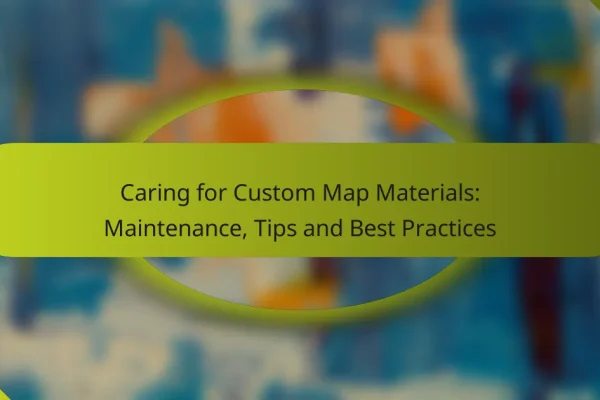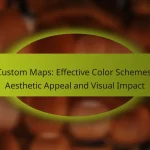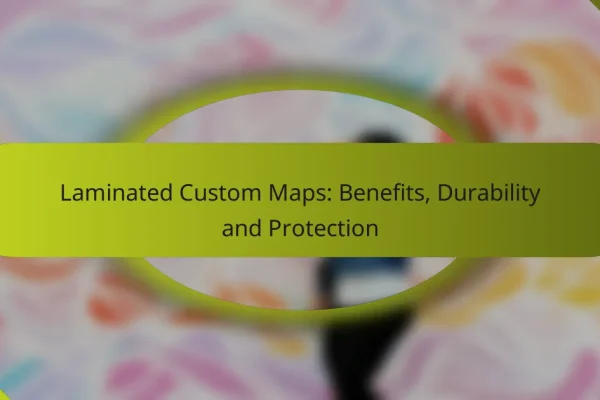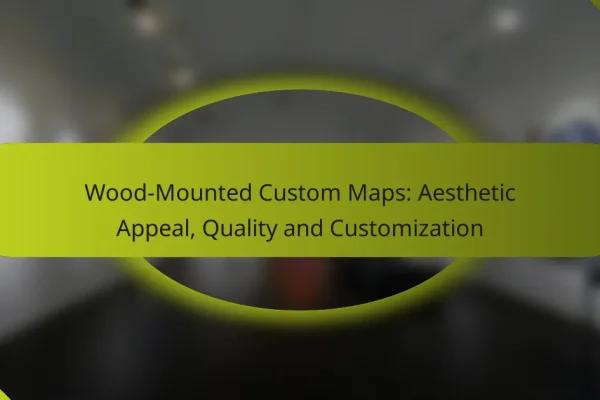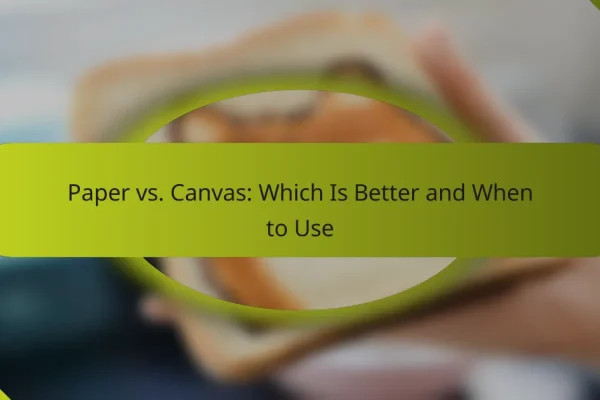What materials are best for custom maps?
The best materials for custom maps depend on the intended use and desired aesthetic. Options like paper, vinyl, canvas, and wood each offer unique benefits that cater to different needs, from durability to texture.
Paper types for durability
When selecting paper for custom maps, consider options like cardstock or synthetic paper. These materials provide a balance of durability and print quality, making them suitable for both indoor and light outdoor use.
For enhanced longevity, look for acid-free or archival-quality paper, which resists yellowing and degradation over time. This is especially important for maps intended for display or preservation.
Vinyl for waterproofing
Vinyl is an excellent choice for custom maps that need to withstand moisture or outdoor conditions. Its waterproof nature ensures that maps remain intact even in wet environments, making it ideal for hiking or boating.
When choosing vinyl, consider thickness and flexibility. Thicker vinyl tends to be more durable, while thinner options may be easier to fold and store. Look for UV-resistant vinyl to prevent fading from sunlight exposure.
Canvas for texture
Canvas offers a unique texture that adds a tactile dimension to custom maps. This material is often used for artistic representations, providing a rustic and sophisticated look.
Canvas is durable and can be stretched over frames for display. However, it may not be suitable for maps that require high detail, as the texture can obscure fine lines. Consider using a high-resolution print to maintain clarity.
Wood for a rustic look
Wooden maps provide a distinctive, rustic aesthetic that appeals to many. They can be carved or printed onto wood, creating a visually striking piece that serves as both art and a functional map.
When using wood, consider the type of wood and finish. Plywood is often used for its affordability and ease of handling, while hardwoods offer greater durability and a premium appearance. Ensure that the wood is treated to resist warping or damage from humidity.
How to choose materials for custom maps in the USA?
Choosing materials for custom maps in the USA involves considering durability, aesthetics, and environmental factors. Selecting the right material ensures that your map meets both functional and visual requirements while being suitable for the intended use.
Consider climate impact
When selecting materials for custom maps, consider the climate where the map will be used. For outdoor maps, materials that are weather-resistant, such as laminated paper or synthetic substrates, are ideal. In contrast, indoor maps may use standard paper or cardstock, which are less durable but more cost-effective.
Additionally, think about the environmental impact of your material choices. Opt for recycled or sustainably sourced materials when possible to minimize your ecological footprint.
Evaluate local printing options
Local printing options can significantly influence your material choice for custom maps. Research nearby print shops to understand their capabilities and the materials they offer. Many local printers provide a range of options, from standard paper to specialty materials like vinyl or canvas.
Compare pricing and turnaround times among local vendors to ensure you get the best value. Some printers may offer discounts for bulk orders, which can be beneficial if you need multiple copies of your map.
Assess material availability
Material availability can vary by region, so it’s essential to check what is accessible in your area. Common materials like paper and cardstock are widely available, but specialty materials may require advance ordering or sourcing from specific suppliers.
Consider contacting suppliers directly to inquire about lead times and minimum order quantities. This proactive approach can help you avoid delays and ensure that you have the right materials for your custom maps.
What are the costs of custom map materials?
The costs of custom map materials vary significantly based on the type of material used, the complexity of the design, and the printing process. Generally, you can expect to pay anywhere from a few dollars for basic paper maps to several hundred for high-quality canvas or vinyl options.
Price ranges for paper maps
Paper maps typically range from about $5 to $50, depending on size and detail. Basic printed maps for personal use or small projects are usually on the lower end of this spectrum, while more intricate designs or larger formats can cost more.
When budgeting for paper maps, consider additional costs such as shipping or framing if needed. It’s often more economical to order in bulk if you require multiple copies.
Cost of vinyl maps
Vinyl maps are more durable and can range from approximately $20 to $150. The price largely depends on the size and customization options, such as lamination or weatherproofing.
These maps are ideal for outdoor use, as they resist tearing and moisture. When selecting vinyl maps, ensure you factor in the intended use to choose the right thickness and finish.
Budget for canvas maps
Canvas maps are generally priced between $50 and $300, reflecting their artistic quality and durability. The cost can increase with larger sizes or more complex designs.
Canvas maps are often used for decorative purposes and can be framed for display. When planning your budget, consider the long-term value of a canvas map, as it can serve as both a functional item and a piece of art.
What are the benefits of using eco-friendly materials for custom maps?
Using eco-friendly materials for custom maps significantly reduces environmental harm while appealing to a growing market of eco-conscious consumers. These materials often come from sustainable sources and can be recycled or biodegradable, making them a responsible choice for map production.
Reduced environmental impact
Eco-friendly materials, such as recycled paper or sustainably sourced wood, help minimize the depletion of natural resources. By choosing these options, businesses can lower their carbon footprint and contribute to a healthier planet.
For example, using recycled paper can reduce energy consumption by up to 60% compared to traditional paper production. This not only conserves resources but also decreases waste, as these materials can often be repurposed after use.
Appeal to eco-conscious customers
As consumers become more environmentally aware, they increasingly prefer products that reflect their values. Custom maps made from eco-friendly materials can attract these customers, enhancing brand loyalty and potentially increasing sales.
Marketing your maps as eco-friendly can differentiate your offerings in a competitive market. Highlighting the sustainable aspects of your materials can resonate with customers who prioritize environmental responsibility, leading to a stronger connection with your brand.
How do different materials affect map printing quality?
Different materials significantly impact the quality of printed maps, influencing factors such as resolution and color vibrancy. Choosing the right material can enhance the visual appeal and durability of the map, making it essential for effective presentation.
Resolution differences
Resolution refers to the detail an image holds, which is crucial for map clarity. Higher resolution materials, such as premium photo paper or canvas, can display intricate details and fine lines more effectively than standard paper.
When selecting materials, consider the intended viewing distance. For maps viewed up close, aim for a resolution of at least 300 DPI (dots per inch). For larger maps viewed from a distance, a resolution of 150 DPI may suffice.
Color vibrancy variations
Color vibrancy is affected by the type of material used, as different surfaces absorb and reflect ink differently. Glossy finishes tend to enhance color saturation, making hues appear more vivid, while matte finishes can provide a softer, more subdued look.
For maps that require bright and bold colors, opt for materials like satin or glossy paper. If a more understated aesthetic is desired, consider using uncoated or matte paper. Always test print samples to see how colors translate on your chosen material.
